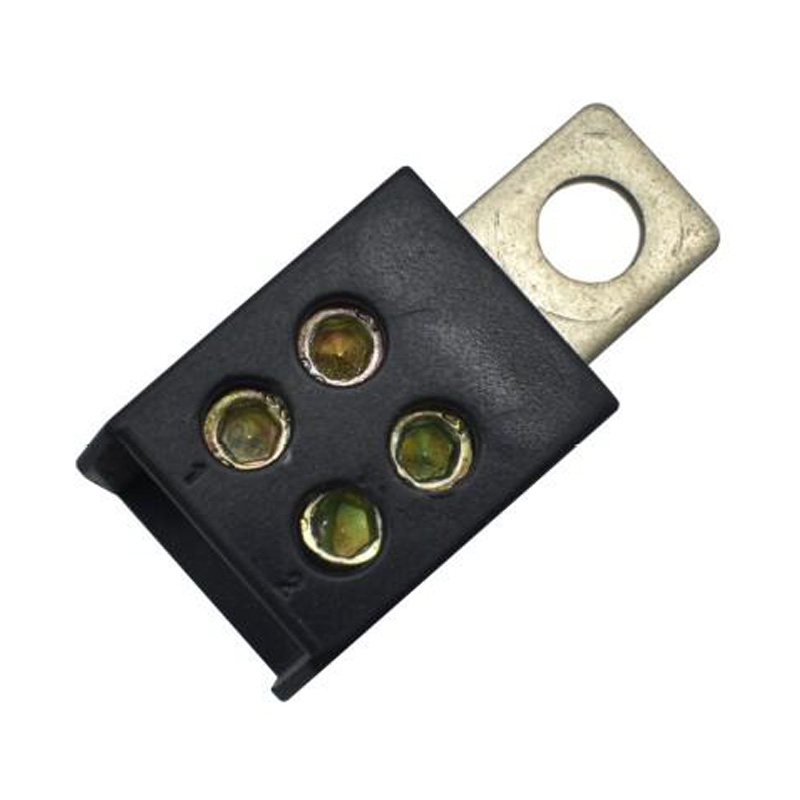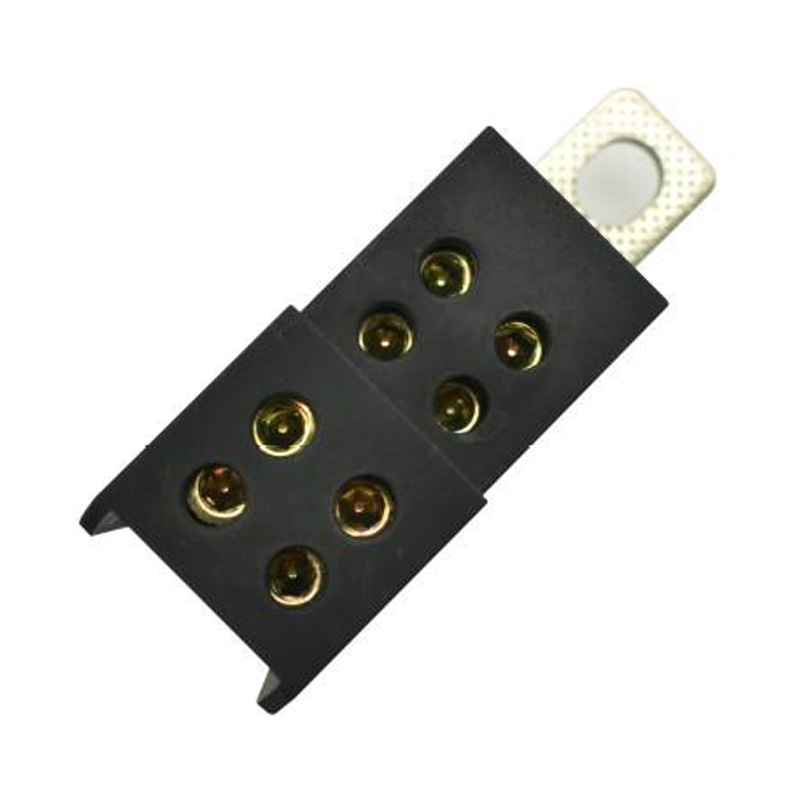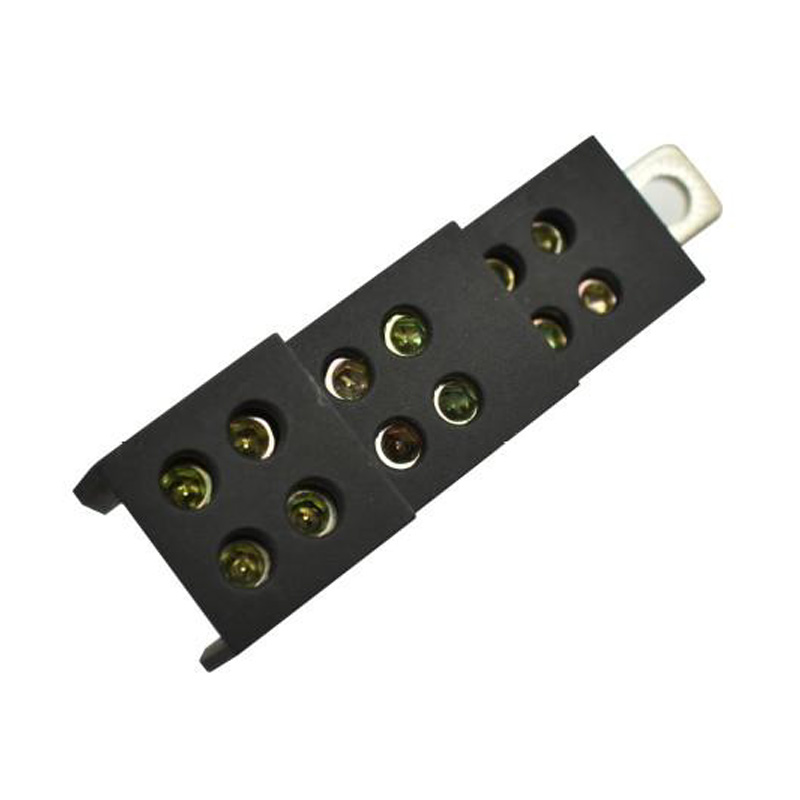In modern electrical control panels, a dual row terminal block combined with Din Rail Terminal Blocks provides an efficient soluti...
READ MOREEquipped with Circuit Breaker Switch Terminal Manufacturer
Terminal Blocks Equipped with Circuit Breaker Switches are professionally used for creating secure, reliable, and protected electrical connections in a wide range of applications. These terminal blocks are specifically designed to integrate circuit breaker switches directly into the terminal block, providing an all-in-one solution for electrical connections and overcurrent protection. This makes them ideal for use in control panels, distribution boards, and other electrical systems where safety and ease of installation are critical.
These terminal blocks feature a robust design that ensures durability and reliability, even under continuous electrical load and varying environmental conditions. The integrated circuit breaker switch provides overcurrent protection, ensuring the safety and stability of the electrical system.
Terminal Blocks Equipped with Circuit Breaker Switches are currently a versatile and reliable solution for managing electrical connections with built-in protection. They simplify the installation process by providing a single unit that combines connection and protection, enhance system safety and reliability through their integrated circuit breaker, and ensure consistent electrical performance. Their robust and protective design makes them suitable for a wide range of residential, commercial, and industrial applications where maintaining a safe and efficient electrical system is essential.
FJ6GD-100.250/2x 16(25) Jack-Up Switch Terminal
Model:FJ6GD-100.250/2x16(25)
One-in-two-out self-lifting switch terminal
Order number:152457
FJ6GD-100.250/4x16 Jack-Up Switch Terminal
Model:FJ6GD-100.250/4x16
One-in-four-out self-lifting switch terminal
Order number:152458
FJ6GD-100.250/6x16 Jack-Up Switch Terminal
Model:FJ6GD-100.250/6x 16
One-in-six-out self-lifting switch terminal
Order number:152459
Search
Categories
-
Energy Measuring Terminal Block(314)
- Energy Measuring Joint Terminal Block(16)
- Polycarbonate Energy Measuring Terminal Block(24)
- Standard Wiring Energy Measuring Terminal Block(4)
- Transparent Shell Energy Measuring Terminal Block(6)
- Multifunctional Test Energy Measuring Terminal Block(10)
- Intelligent Safety Energy Measuring Terminal Block(6)
- Single-Phase Multi-Circuit Output Terminal Block(12)
- Self-Elevating Metering Box Terminal Block(7)
- One Household One-Meter Meter Box Dedicated Terminal Block(56)
- Three-Phase Metering Box Dedicated Terminal Block(24)
- Repeatable Grounding Line Terminal Block(20)
- Terminal Block for One-Inlet Multi-Outlet Metering Box(15)
- Closed Terminal Block(11)
- Heavy Current Terminal Block(48)
- Self-Boosting Terminal Block(5)
- Intelligent Self-Locking Terminal Block(3)
- Tool-Free Crimping Type Terminal Block(5)
- Wide Range of Wire Diameters Terminal Block(5)
- Combined Type Energy Measuring Terminal Block(37)
-
Switch Terminal Block(55)
- Pin-Type Incoming Line Switch Terminal Block(4)
- Multi-Way Connection Switch Terminal Block(4)
- Plug-pin Switch Terminal Block(7)
- Combined Type Switch Terminal Block(7)
- High Contact Cross Section Switch Terminal Block(7)
- Wide Range Switch Terminal Block(11)
- One Way in Switch Terminal Block(12)
- Equipped with Circuit Breaker Switch Terminal(3)
-
Heavy-current Terminal Block(631)
- Modular Building Block Terminal Block(156)
- Spherical Non-Destructive Crimp Terminal(120)
- Dual-Mode Connection Electrical Terminal(90)
- Anti-Electricity-Theft Terminal Block(74)
- Convenient Connection Terminal Block(12)
- High-Contact Section Terminal Block(12)
- Wide Range of Wire Diameters Neutral Line Terminal(9)
- Heavy-Current Neutral Line Terminal(9)
- Upper and Lower Rows of Neutral Terminal(2)
- Independent Neutral Line Terminal(7)
- Nose-Type Neutral Line Terminal(7)
- Rail Type Neutral Line Terminal(9)
- Fixed Neutral Line Terminal(12)
- Double Rail Assembly Electrical Terminal(19)
- Blue Jack-Up Terminal(6)
- Black Base Copper Bar Terminal(5)
- Compact Terminal Block(16)
- Precision Terminal Block(23)
- U-Shaped Harpoon Terminal(2)
- Grounding Metering Box Terminal Block(12)
- High-Performance Terminal Block(19)
- Multifunctional Terminal Block(10)
- Din Rail Terminal Block(76)
- Watt-hour Meter Connector(49)
-
Energy Meter Accessories(116)
-
-
As electrical systems become more advanced, the demand for more reliable, durable, and efficient components grows. Connectors Term...
READ MORE -
Ensuring that connector terminals are properly installed is critical for the long-term performance and reliability of any electric...
READ MORE -
Selecting the correct terminal is essential for the stability and efficiency of any electrical system. For professionals in the el...
READ MORE -
Electrical systems rely on high-quality components for safe, efficient, and reliable operation. One such crucial element is the co...
READ MORE -
Using the right junction box and circuit breaker block junction box can bring more than safety — it can significantly improve inst...
READ MORE
What Environmental Factors Affect Circuit Breaker Switch Terminals?
Circuit breaker terminals must function properly in various operating environments. Their reliability depends heavily on how they withstand external influences. Three main environmental factors play a significant role:
1. Temperature Variations:
High ambient temperatures can accelerate the oxidation of terminal surfaces, reducing conductivity over time. On the other hand, cold can make materials brittle, which may cracks or poor clamping. Thermal expansion and contraction cycles also stress the metal, potentially loosening connections. To maintain performance, terminals must be chosen with materials and coatings suitable for expected temperature ranges.
2. Humidity and Moisture:
Moisture is a common cause of corrosion in electrical terminals. When condensation builds up in control panels or outdoor enclosures, it can increase contact resistance,overheating. Over time, this may result in terminal failure or even electrical fires. Using terminals with anti-corrosion plating, combined with proper enclosure sealing and ventilation, helps minimize these risks.
3. Dust and Contaminants:
Dust, industrial fumes, and airborne particles can accumulate on terminals, causing insulation breakdown or short circuits. Contaminants also create a film that interferes with proper electrical contact. Regular cleaning and the use of dust-proof enclosures help mitigate such issues. In industrial areas with heavy pollution, specialized protective coatings may be required.
How to Troubleshoot a Faulty Circuit Breaker Terminal?
When a circuit breaker terminal malfunctions, identifying the root cause is critical for safety and reliability. Troubleshooting can be approached in two main steps:
1. Visual Inspection: Identifying Physical Damage
Start by disconnecting the breaker from the power source to ensure safety. Inspect the terminal for visible signs such as discoloration, burnt marks, corrosion, or loose screws. These issues often indicate overheating or poor contact. Also, check whether the conductor insulation has melted or shows signs of arcing. Such symptoms suggest the terminal has experienced excessive current or mechanical stress. Tightening connections or replacing damaged parts may solve minor issues, but in severe cases, the breaker itself may need replacement.
2. Electrical Testing: Measuring Performance Issues
After physical inspection, use a multimeter to test continuity and resistance at the terminal. High resistance readings typically suggest poor contact or corrosion. If voltage drop tests show significant losses, it indicates that the terminal is not maintaining proper conductivity. Additionally, thermal imaging can help detect hotspots that are not visible to the naked eye. If the terminal consistently shows abnormal readings, it should be replaced to prevent further hazards.
How to Select an MCCB Terminal for High-Current Applications?
Molded case circuit breakers (MCCBs) are commonly used in industrial and commercial installations where high-current protection is required. Choosing the right terminal type is essential to maintain safety and efficiency. Several considerations apply:
1. Current-Carrying Capacity:
The selected terminal must be rated for the expected current. Underrated terminals can overheat, degrade insulation, and eventually fail. Always check manufacturer specifications to ensure the terminal can handle continuous high loads without performance decline.
2. Conductor Compatibility:
High-current applications often use large cross-sectional cables. The MCCB terminal should be designed to accept these conductors without forcing or modification. Options such as lug-type or compression terminals provide secure and stable connections for thick cables.
3. Thermal and Mechanical Strength:
Terminals in high-current systems are exposed to elevated temperatures and mechanical stress from cable bending or vibration. Therefore, materials such as copper alloys with protective coatings are preferable. Terminals should also feature secure fastening mechanisms, such as torque-controlled screws, to prevent loosening.



 English
English Español
Español عربى
عربى








